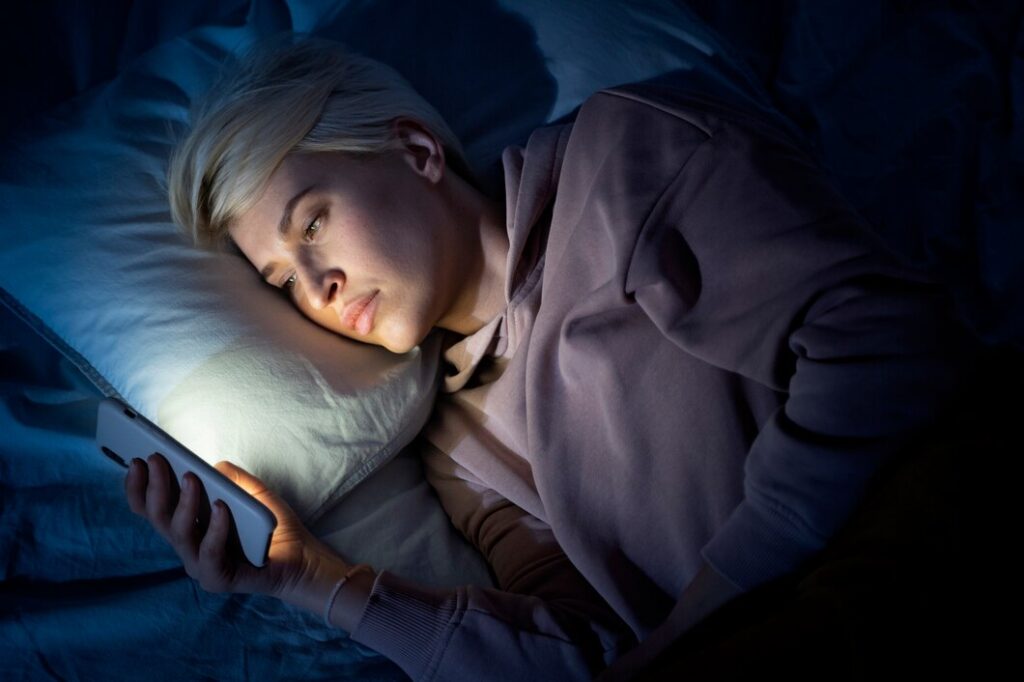Insomnia is a prevalent condition characterized by difficulty initiating or maintaining sleep or waking up prematurely. This disorder has become increasingly common in modern society due to factors such as demanding schedules, elevated stress, and constant digital engagement.
As a result, millions worldwide face challenges in achieving adequate rest, leading to daytime fatigue, mood disturbances, and a reduced quality of life. To effectively manage insomnia, it is crucial to understand the underlying causes of insomnia and the various forms it may take.
Whether from psychological stress, lifestyle factors, or other medical conditions, identifying the root cause is vital in determining an appropriate treatment plan for improving sleep quality.
What is Insomnia?
Insomnia is the inability to achieve restful sleep, which may manifest as insufficient sleep, poor sleep quality, or difficulty falling or staying asleep. For some individuals, insomnia may be a minor disturbance, while for others, it can significantly disrupt daily functioning. The causes of insomnia are diverse and can vary from person to person.
Sleep is essential for numerous physiological and cognitive functions, though the full range of its benefits is still being explored by scientific research. However, it is well-established that insufficient sleep leads to sleep deprivation, which can result in a range of negative effects, including physical discomfort and impaired performance in daily activities.
Chronic Insomnia Characteristics
Persistent difficulties in achieving restful sleep define chronic insomnia, and its characteristics can vary depending on the individual’s sleep patterns. Sleep needs and habits differ significantly, and experts acknowledge a wide range of sleep behaviors as normal. Some examples include:
- Early risers: Individuals who naturally prefer to go to bed early and wake up early.
- Night owls: Individuals who tend to stay up late and wake up later.
- Short sleepers: Individuals naturally require less sleep, with research suggesting a potential genetic basis for this trait.
Certain symptoms and patterns are critical in making a diagnosis in the context of chronic insomnia. Key characteristics include:
- Circumstances: Chronic insomnia is diagnosed when sleep difficulties persist despite the absence of external factors, such as a change in work schedule or significant life events, that could disrupt sleep.
- Frequency: For a diagnosis of chronic insomnia, sleep disturbances must occur at least three times per week.
- Duration: Chronic insomnia is defined by its persistence for at least three months.
Insomnia Symptoms
Both sleep-related difficulties and daytime impairments characterize insomnia. Common sleep-related symptoms include:
- Difficulty falling asleep
- Difficulty staying asleep
- Waking up too early in the morning
- Resistance to sleep at bedtime (common in children and teens)
- Sleeping problems without a caregiver’s assistance (in children and teens)
Daytime symptoms resulting from sleep deprivation include fatigue, impairing attention, memory, and overall performance at work, school, or social settings. Insomnia may also increase the risk of accidents and negatively impact behavioral health, leading to irritability, hyperactivity, or aggressiveness, particularly in children.
Types of Insomnia
Insomnia is classified into several types based on its duration and underlying causes:
- Acute insomnia: Short-term sleep disturbances that typically last for a few weeks.
- Chronic insomnia: A long-term condition affecting sleep at least three times a week for three months or more. It can be either primary (idiopathic) or secondary (associated with other medical or psychiatric conditions).
- Onset insomnia: Difficulty falling asleep, often triggered by factors such as caffeine use, mental health issues, or other common causes, but it can also be associated with other sleep disorders.
- Maintenance insomnia: This form may be linked to underlying health or mental health conditions, and excessive worry about not getting enough sleep can exacerbate the problem.
- Behavioral insomnia of childhood: Persistent difficulty falling asleep or refusal to go to bed. Children with this condition often benefit from learning self-soothing techniques and establishing a consistent sleep routine.
Insomnia Causes and Risk Factors
The causes of insomnia depend on various types.
Possible causes of acute insomnia include recent stressors, such as traumatic events or jet lag.
Chronic insomnia can occur as a result of:
- Psychological conditions such as anxiety, depression, or substance use disorders
- Sleep disorders, such as sleep apnea
- Health conditions such as diabetes or gastroesophageal reflux disease (GERD)
Insomnia is related to age, sex, and genetics. It’s more common:
- In older adulthood
- Just before, during, and after menopause
- People who are pregnant
Other risk factors associated with insomnia include:
- A sedentary lifestyle
- Shift work
- Taking naps
- Drinking caffeine
Complications of Insomnia
Severe or prolonged insomnia can lead to sleeping problems, which are a significant concern due to their impact on daytime alertness. Excessive sleepiness during the day can be dangerous, mainly when performing activities that require concentration, such as driving.
Sleep deprivation also increases the risk of developing several health conditions, including:
- Depression
- Anxiety
- Hypertension (high blood pressure)
- Heart attack
- Stroke
- Obstructive sleep apnea
- Type 2 diabetes
- Obesity
- Psychotic disorders
Insomnia in Children
Children and teens can develop insomnia for similar reasons as adults. Symptoms may include:
- Daytime sleepiness or restlessness
- Irritability and mood swings
- Frequent disciplinary issues
- Problems with memory and concentration
The first step in addressing insomnia in children typically involves establishing a consistent bedtime routine. Other effective strategies include:
- Creating a calming pre-sleep routine
- Practicing good sleep hygiene
- Reducing stressors in the child’s life
For additional support, a therapist or pediatrician can provide further guidance on managing insomnia in children.
Insomnia in Older Adulthood
Insomnia in older adults can be influenced by several factors, which may compound each other:
- Age-related changes in circadian rhythms
- Retirement, which may disrupt daily routines and reduce social interaction
- Social isolation potentially leads to loneliness and an increased risk of depression
- Age-related health issues, such as chronic pain conditions
- Daytime napping, mainly when nighttime sleep is insufficient, which can disrupt the sleep-wake cycle
If insomnia is experienced, seeking support from a therapist or healthcare provider can help identify effective treatment options.
Receiving an Insomnia Diagnosis
To diagnose insomnia, a healthcare professional will inquire about:
- Any existing medical conditions
- Notable physical and mental health symptoms
- Stressors in your personal or work life
- Sleep history, including the duration and impact of symptoms
This information helps identify potential causes of sleep issues. They may also request you to maintain a sleep log (either digital or written) for 2 to 4 weeks, tracking:
- Bedtime and time taken to fall asleep
- Instances of waking during the night
- Wake-up times
Additional medical tests or blood work may be ordered to rule out underlying conditions. If a sleep disorder, such as obstructive sleep apnea, is suspected, a sleep study may be recommended.
Treating Insomnia
There are several treatment options for insomnia, including therapy, medications, supplements, and natural remedies.
Cognitive Behavioral Therapy for Insomnia (CBT-I)
CBT-I, guided by a therapist, involves techniques such as:
- Stimulus control: Encourages getting out of bed and engaging in a quiet activity when unable to sleep.
- Sleep restriction: Limits and gradually increases time spent in bed.
- Bright light therapy: Exposes you to bright light to help regulate sleep patterns.
Therapists may also guide relaxation techniques and sleep hygiene practices and address underlying mental health issues that contribute to insomnia.
Medications and Supplements
If therapy and lifestyle changes are ineffective, medications may be prescribed, including:
- Eszopiclone (Lunesta)
- Zolpidem (Ambien)
- Triazolam (Halcion)
Melatonin supplements may also help with sleep onset but should be used cautiously due to limited long-term safety data.
Other Approaches
Lifestyle changes and natural remedies help to manage symptoms:
- Natural sleep aids: Herbal teas, warm milk, or valerian, and relaxing essential oils like lavender.
- Meditation: Reduces stress and improves sleep quality.
- Acupuncture: This may alleviate insomnia symptoms for some individuals.
- Exercise: Regular physical activity can help enhance sleep quality by promoting melatonin release.
How to Prevent Insomnia
While it may not always be possible to prevent insomnia, the following strategies can help improve your sleep:
- Maintain a consistent sleep-wake schedule, even on weekends.
- Establish a calming bedtime routine to prepare your body and mind for sleep.
- Dim the lights and avoid electronic devices at least an hour before bedtime.
- Avoid napping, particularly if daytime sleep disrupts your ability to sleep at night.
Living With Insomnia
Living with insomnia can be managed with effective sleep hygiene practices, including:
- Set a consistent sleep schedule: Stick to a regular bedtime and wake-up time, even on weekends. Avoid late afternoon or evening naps.
- Create a comfortable sleep environment: Adjust lighting, noise, and temperature to suit your preferences. Consider using a sound generator if needed.
- Limit screen time: Avoid electronic devices before bed, as the light can interfere with sleep cues.
- Be mindful of food and drink: Avoid heavy meals, caffeine, nicotine, and alcohol before bed.
If sleep difficulties persist, consult your healthcare provider to address potential underlying causes and explore solutions.
Conclusion
Insomnia is a sleep disorder that can significantly impact your mental, emotional, and physical health. The causes and risk factors vary depending on the type of insomnia, but effective treatments are available. If you suspect you have insomnia, it is essential to consult a healthcare professional promptly. They can help identify underlying causes and guide you toward the most appropriate treatment options for your needs.
For personalized support and expert guidance, consider contacting Insight Choices to explore the best strategies for managing your sleep.
FAQs
What are the main symptoms of insomnia?
Common symptoms include difficulty falling asleep, staying asleep, waking up too early, daytime fatigue, irritability, and impaired focus.
How can insomnia affect my health?
Insomnia can lead to sleep deprivation, increasing the risk of conditions like depression, anxiety, hypertension, heart disease, and diabetes. It can also impair cognitive function and overall quality of life.
What is the difference between acute and chronic insomnia?
Acute insomnia is short-term and often triggered by stress or life events, while chronic insomnia lasts for at least three months and occurs at least three times per week.
Can children have insomnia?
Yes, children and teens can experience insomnia due to stress, health issues, or poor sleep habits, leading to daytime sleepiness, irritability, and difficulty focusing.
When should I see a doctor for insomnia?
If your sleep problems persist for more than a few weeks, occur frequently, or significantly impact your daily life, it’s essential to consult a healthcare professional.

Dr. Chang is a highly respected psychiatrist with extensive experience serving patients in the greater Los Angeles area. With a distinguished background in psychiatry, he has dedicated his career to advancing mental health care through both clinical practice and academic contributions.

